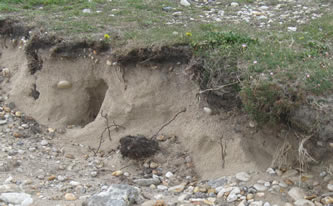Chesil Beach and the Fleet Lagoon
18 miles and 180 billion pebbles


Hamm Beach is. like Chesil Beach, a shingle tombolo. While Chesil was formed by material moving south and east from Lyme Bay, the Hamm tombolo was formed by debris falling from the cliffs at East Weares on Portland and being transported northwards to form Hamm Beach. This tomobolo can be clearly seen in old postcards dating before the the navy started developing the site. The northern limit of the tombolo was the entrance to the Fleet.
The pebbles on Hamm Beach are very irregular in shape and size compared with Chesil Beach because of the much reduced wave action.

The seabed in front of the beach is sand and this is part of the extensive areas of sand in Weymouth Bay. At spring low water large areas of the sand are exposed and strong easterly winds blew this sand onshore to form shallow sand dunes on the shingle tombolo.

When the Portland Harbour breakwaters and naval base were built this cut-off the supply of shingle and sand so Hamm Beach is now a closed system with no fresh supply of material.
The Weymouth to Portland railway line ran the whole length of Hamm Beach and was built by building up ballast on top of the sand and shingle and digging deep drainage ditches alongside the track.

In more recent times a new bridge and channel for the Fleet has been built at Ferrybridge. This has left a short section of Hamm Beach isolated between the new and the old channels.
Chesil Beach is also retreating at about 15cm per year towards Hamm Beach and at the southern limit of Hamm Beach overwash from Chesil Beach has transported Chesil pebbles onto Hamm Beach.
The layer of sand is about 30cms thick and overlays the shingle.
Track bed of the disused Portland railway

This postcard from 1900 shows the tombolo stretching from the current southern end of Hamm Beach towards the eastern part of Portland. The tombolo has been breached to allow boats through.
Over the last two hundred years the dynamic environment of Hamm Beach has been more and more constrained by the activities of man. The breakwaters stopped the northwards drift of material and reduced the wave activity on the beach. The building of the road and railway further constrained the dynamic processes affecting the beach. More information on this is presented here.





